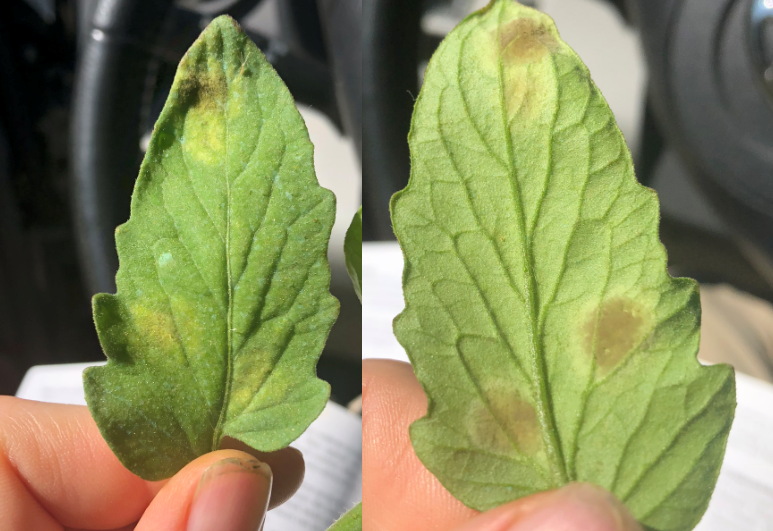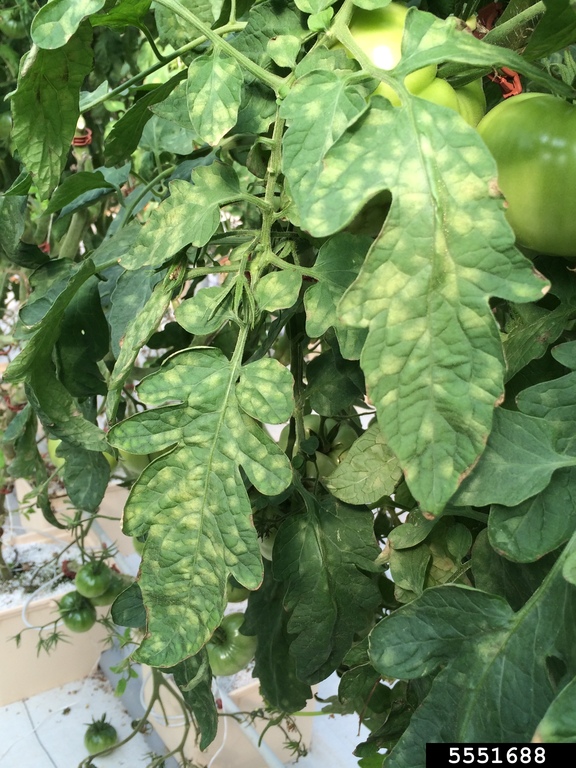Tomato leaf mold in hoophouse tomatoes
High hoophouse humidity can lead to tomato leaf mold. Learn about disease basics and organic and conventional control options here.

Hoophouse tomatoes are one of the biggest moneymakers on small farms. While the hoophouse provides relief from many tomato diseases, some plant diseases are favored by the high relative humidity that can occur in hoophouses and greenhouses. Tomato leaf mold (Passalora fulva) is one of these diseases, and due to its biology, it can become a frustrating and recurring issue.
What is tomato leaf mold?
Tomato leaf mold is a fungal disease that can develop when there are extended periods of leaf wetness and the relative humidity is high (greater than 85 percent). Due to this moisture requirement, the disease is seen primarily in hoophouses and greenhouses. Tomato leaf mold can develop during early spring temperatures (50.9 degrees Fahrenheit) or those characteristic of summer (90 F). The optimal temperature tomato leaf mold is in the low 70s.
Symptoms of disease include yellow spots on the upper leaf surface. Discrete masses of olive-green spores can be seen on the underside of the affected leaves. The older leaves become infected first and die prematurely. The pathogen may spread rapidly during periods of prolonged relative humidity. The disease can cause flowers to drop but usually does not affect developing fruit. If infection occurs late in the season, yield losses will be minimal, but if the disease takes hold earlier, the premature defoliation will impact yield.
The pathogen survives by forming scleortia (familiar to those who have dealt white mold) that can survive in the hoophouse or greenhouse to infect future tomato plants when the conditions are right.

What can be done about tomato leaf mold?
Within the season
Limiting the relative humidity in the hoophouse can help to prevent this disease. Vent, if possible, to promote air movement. Increase plant spacing, remove weeds, and prune and trellis plants. Consider using drip irrigation to minimize leaf wetness. If watering overhead, irrigate in the morning so foliage can dry quickly.
There are organic preventive products available, which vary in price but performed similarly in Cornell University trials. Products trialed include Champ (Copper Hydroxide), Double Nickle (Bacillus amyloliquefaciens), Oxidate (Hydrogen dioxide), Regalia (Reynoutria sachalinensis extract) and Zonix (Rhamnolipid biosurfactant). While the treatments did reduce the amount of tomato leaf mold, the disease level was still high. In this trial, all treatments performed comparably, but when price is brought into consideration, the copper product Champ gave the best value. Note, only certain copper hydroxide formulations are approved for organic use, including Champ WG and Kocide 3000-O, and formulations with a higher percentage of active ingredient increase the Re-Entry Interval (REI) to 48 hours. Copper products with a lower percentage of active ingredient will lower the REI, but do not work as well against this disease. For more information on product trials, see “Managing Leaf Mold in High Tunnel Production.”
Conventional fungicides available for treating this disease include mancozeb formulations, Revus Top (mandipropamid + difenoconazole) and Tanos (cymoxanil + famoxadone). See the table below for more information on rates and greenhouse use for the products from the Cornell study, and conventional fungicides
|
Fungicides for leaf mold of tomatoes – Passalora fungus | ||||
|---|---|---|---|---|
|
Product (*= OMRI label) |
FRAC Mode of action |
Rate |
PHI/REI |
Greenhouse Use? |
|
Kocide*, Champ*, others |
M1 |
Various rates depending on formulation. |
0 day/48 hours or see label depending on formulation. |
Check label, most are silent or yes |
|
Manzate, Koverall, others |
M3 |
Various rates depending on formulation. |
7 days/24 hours or see label depending on formulation. |
Silent or yes |
|
Tanos |
7 + 9 |
8.0 – 10.0 fl. oz. per acre |
3 days/12 hours |
Silent |
|
Revus Top |
40 + 3 |
5.5 – 7.0 fl. oz. per acre |
1 day/12 hours |
Silent |
|
Double Nickel LC* |
44 |
0.5 – 6 qt. per acre |
0 day/4 hours |
Silent |
|
Oxidate* |
NC + NC |
32 fl. oz. – 2.5 gal. per 100 gal. water depending on severity |
0-day/1 hour |
Yes, do not apply high rate to flowering crop |
|
Regalia* |
P5 |
1.0 – 4.0 qt. per acre |
0 day/4 hours |
Silent |
|
Zonix* |
NC |
45 – 76 fl. oz. per 100 gal of water |
Silent/4 hours |
Yes |

Destroying crop residue is also important to reduce the number of sclerotia in the hoophouse. Sanitizing the interior of the house as well as any stakes and tools that contacted the plants will reduce the inoculum load next year.
Long-term
If this is a perennial issue in your hoophouse, choosing resistant varieties will be a cornerstone of management. Cornell has developed a list of cherry and slicer type tomatoes that have performed well in New York. For an overview of tomato leaf mold and the varieties recommended in New York, see “Leaf Mold in High Tunnel Tomatoes.” Note that tomato leaf mold has many strains, and it isn’t known how the varieties recommended in New York would respond to Michigan strains of tomato leaf mold.



 Print
Print Email
Email